Dryanovo – spirit and stone
- Stefan Ivanov

- May 1
- 17 min read
Updated: Oct 10
Dryanovo is located in the heart of Bulgaria and represents an exceptional historical and cultural phenomenon.

Its development is not just local history, but a microcosm of Bulgarian civilization, tracing its roots from the deepest prehistory, passing through the eras of Thracians, Romans, medieval fortresses, and reaching its peak as a cradle of architectural genius and a symbol of national heroism during the Bulgarian Renaissance.
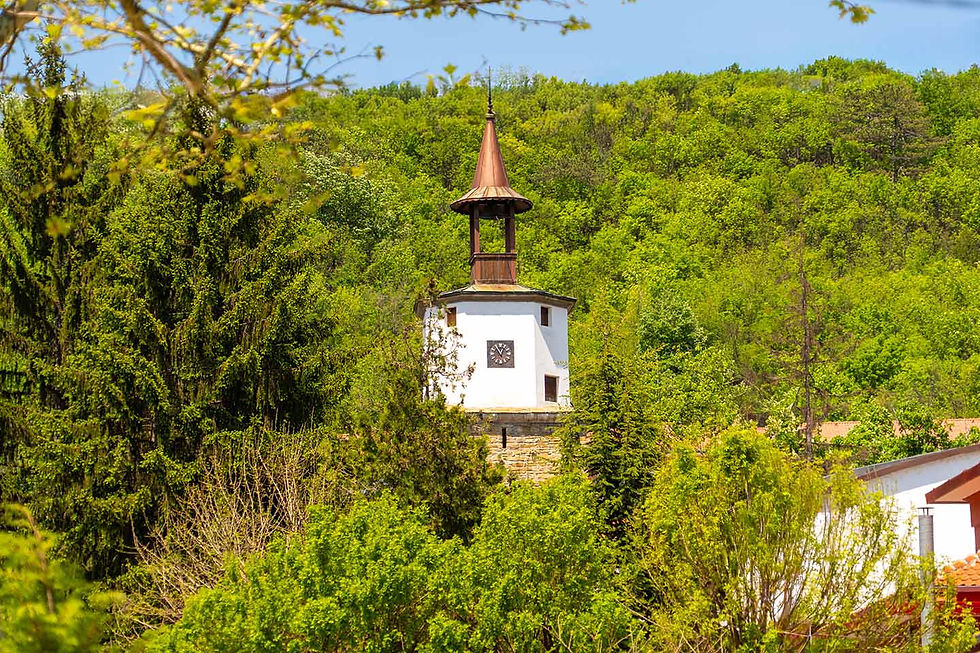
Dryanovo is strategically located at the northern foothills of the Central Balkans, surrounded by picturesque hills that shyly reveal remains of ancient fortifications.

The city is formed around the banks of the Dryanovska River, which is a significant tributary of the Yantra River.

This location has been of immense importance throughout human history, as it controlled access between the Danube Plain and the interior of the Balkan Mountains, making the region important for both trade and defense.

The relief of the area is closely related to the karst morphology, formed by strong Orgon limestones.

Over millions of years, underground rivers have carved out complex systems of caves and canyons.

This geological feature not only creates unique natural landmarks, but also provides protected refuges that were critical for the earliest human habitation.
Bacho Kiro Cave - an archaeological phenomenon
In the immediate vicinity of the Dryanovo Monastery "St. Archangel Michael" is the Bacho Kiro Cave - a natural landmark and architectural and construction monument of the culture of Antiquity and the Middle Ages, which is one of the most significant archaeological sites in Europe and is listed at number 22 of the Hundred National Tourist Sites of Bulgaria.

The cave is a complex four-story labyrinth of galleries with a total length of about 3,600 meters.

Geomorphological studies suggest that its formation lasted an impressive 1.8 million years, with its formation being closely related to the development of the valleys of the Dryanovska River and its tributary, the Andaka River.

Archaeological excavations in the cave have revealed traces of human presence from the Middle and Late Paleolithic and categorize it as the site of the most ancient Paleolithic settlement in Central Europe.

This fact highlights the Dryanovo region as a key point for the migration and development of human civilization on the continent.

The fact that the earliest traces of human activity and the most ancient Paleolithic settlement were discovered right next to the Dryanovo Monastery "St. Archangel Michael", which later became a center of national heroism and spirituality, shows a remarkable continuity of habitation.

The specific microclimate and protected natural conditions of this canyon have provided viability and strategic attractiveness for human presence for centuries.

This connects the prehistoric need for physical survival with the Bulgarian Renaissance need for national and spiritual survival.
Antiquity and Early Middle Ages – Thracian-Roman Heritage
After the Paleolithic, the region continued to be inhabited, with archaeological evidence of local Eneolithic and Bronze Age cultures. Later, Thracians, Romans and Byzantines built their settlements, tombs, fortresses and towers near Dryanovo.

The remains of these fortresses, built by various peoples over the centuries – Thracians, Romans and Bulgarians, are still visible on the steep hills above the town. These structures are evidence of the constant defensive and logistical importance of the area, especially in relation to the mountain passes.
Not far from Dryanovo is the Roman market of Discoduratera, which further emphasizes the role of the region as an important trade center in Antiquity. The market can also be reached via a specialized tourist route with a guide, which lasts about 6 hours.
Dryanovo in the Middle Ages – the birth of a spiritual center
The modern village of Dryanovo is one of the Bulgarian Renaissance towns, but its roots in the Middle Ages are noted as a critical stronghold. Chroniclers first mentioned the village as a fortress at the end of the 12th century.

This historical context is extremely important, as it coincides with the period in which the Asenevtsi brothers liberated Bulgaria from Byzantine rule. The first written mention of Dryanovo as a fortress immediately after the restoration of the Bulgarian state indicates that the settlement was critical for the protection of the mountain approaches to the new capital - Veliko Tarnovo. This emphasizes not only the defensive, but also the logistical importance of the region during the state restoration, integrating the geographical position, previously important for Roman trade, into the Bulgarian state strategy.

The name of the present-day town comes from the dogwood tree. In Bulgarian tradition, this tree symbolizes toughness and endurance, qualities that metaphorically reflect the character of the local mountaineers and their spirit during the difficult centuries.
Medieval defensive structures
There were numerous medieval defensive structures in the Dryanovo region. Not far from the town, the remains of the fortresses "Boruna" and "Gradat" can be found, which were part of the defensive network protecting the pass and the surrounding roads to Tarnovgrad.

Dryanovo Monastery "St. Archangel Michael"
The Dryanovo Monastery "St. Archangel Michael" was founded precisely during the period of the Second Bulgarian Empire.

Located about 4 kilometers southwest of the city, it quickly became an important spiritual and educational center.

The monastery played an exceptional role in preserving the Christian faith and the national spirit during the centuries of Ottoman rule.
The Bulgarian Renaissance
Like most Balkan villages located in the relatively protected mountainous area, Dryanovo reached its economic and social peak during the era of the Bulgarian Renaissance.

This period was characterized by a strong development of crafts, trade, and the formation of a stable and wealthy civic class.

This economic power created the prerequisites for large-scale construction and a cultural upsurge, which led to the birth and establishment of the most famous Bulgarian builder of that time - Master Nikola Ivanov Fichev.

Master Kolyu Ficheto
Nikola Fichev, known as Usta Kolyu Ficheto or Master Nikola Ivanov Fichev, was born in Dryanovo in 1800.

He began learning the construction trade initially with local carpenters, but in 1830 he left for Tarnovo, where he continued his studies with famous masters such as Usta Veliu and Staniu Marangozina.

His craftsmanship was formed through collaboration with masters from various schools, including Bratsigovo, Korça, as well as Italian workers. His horizon was also broadened by his travels to Constantinople, Wallachia, and Moldavia, where he became acquainted with the achievements of modern architecture, while at the same time drawing inspiration from the old churches of Tarnovo.

Recognition as an independent master came in 1836, when he completed the St. Nicholas Church in Tarnovo, replacing the ill master and incorporating his own original ideas into the interior design of the building.

He then continued his 40-year career, building a number of churches, fountains, public buildings, houses, and bridges, which established him as a Renaissance architect with a unique creative individuality.

Ficheto's Major Buildings in Dryanovo
In his hometown of Dryanovo, Kolyu Ficheto left behind several sites that are emblematic of his mastery and the cultural identity of the city.
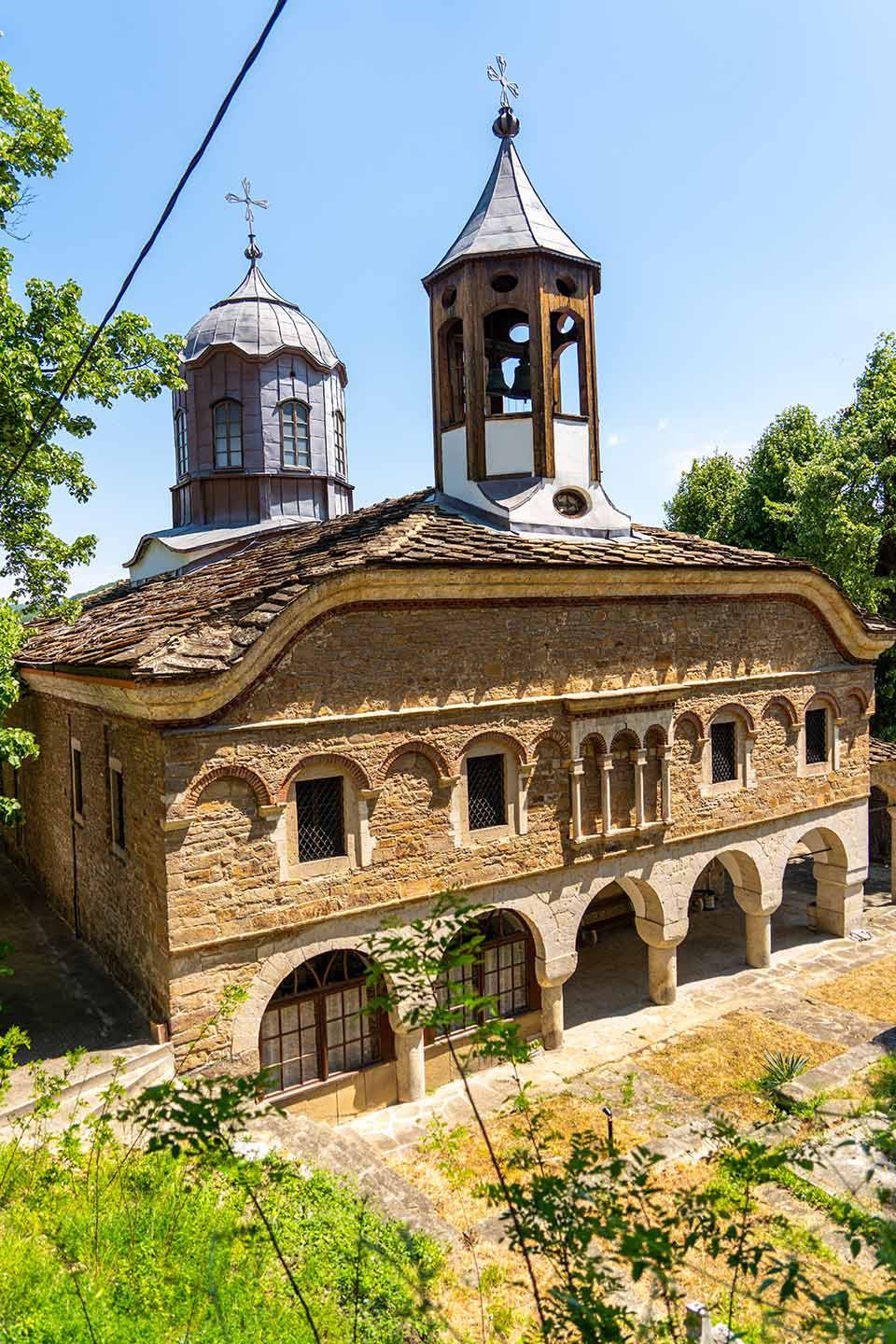
The Church of St. Nicholas is one of the surviving buildings that demonstrates its unique architectural style.

The steward's house, built in 1859, is among its preserved buildings, and today it houses the collection of the Historical Museum of Dryanovo.

The bridge over the Dryanovska River, located about 1.5 kilometers from the museum, is a symbol of engineering excellence and professional ethics.

The master was known for lying under a bridge when testing it to ensure its safety with his life.
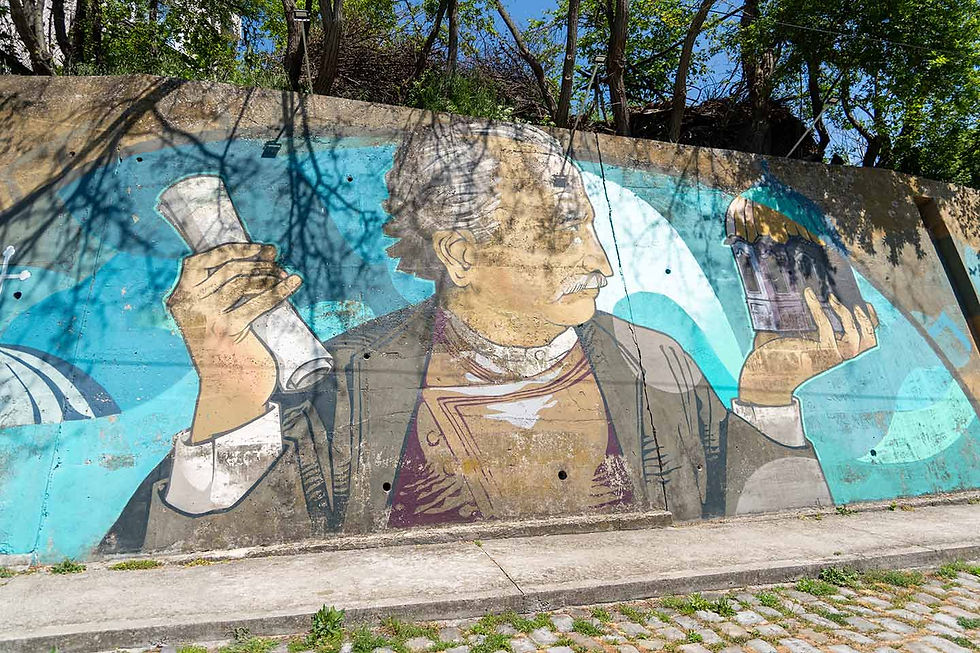
This practice is not simply a demonstration of engineering self-confidence, but rather a social and moral contract with the community, symbolizing honesty and unconditional quality – core values that drove the Renaissance era.

Kolyu Ficheto's legacy is preserved in the Historical Museum in Dryanovo, which is dedicated to his life and work and is included in the 100 National Tourist Sites.

The exhibition presents models of his most famous buildings, photographs, information about the constructions, as well as a sample of the 2,000 leva banknote with the master's image, which was in circulation from 1996 to 1999.
Cultural and educational work
Cultural life during the Bulgarian Renaissance was closely connected with spiritual and educational progress. The Iconomov House, part of the Historical Museum, houses a collection of medieval icons collected from local temples.

This collection is dominated by the masterpieces of the icon painters of the famous Tryavna School, who worked in the 19th century. This shows that Dryanovo was an important cultural crossroads, where architectural genius and icon-painting tradition intersected.
Lafchieva House in Dryanovo, also known as the House Without Nails, and the "Created by the Earth" exhibition
Lafchieva House in the town of Dryanovo is one of the most significant and unique architectural monuments from the period of the Bulgarian Renaissance.

Declared a cultural monument of national importance, the building is a focal point for research into the construction techniques, economic prosperity and social structure of the Bulgarian city from the mid-19th century.
I tell and show you in detail about Lafchievata Kashta HERE.
The Clock Tower
An impressive architectural landmark from the same period is the city's clock tower.

The clock tower in Dryanovo is one of the symbols of the city.

The structure we all see today is not the original clock tower. The original tower was built in 1778, making Dryanovo one of the first Bulgarian settlements with such a tower. Its construction was a clear sign of a thriving settlement and was intended to support developing crafts by notifying craftsmen of the exact time (the beginning and end of the working day).

I do not have data on the first and original clock mechanism, but the one that still works today was made in 1883 by Tryavna craftsmen Gencho Kolev and Hristo Vassilev.
The original tower was a tall, centric building, composed of three bodies of varying height. The lower part was made of rough stone with a square base, and above it the four-sided prism passed into an octagonal part, where the mechanism was located.

The tower was demolished in 1945 due to cracks and lack of restoration. It was restored in 1984 according to a project by architect Iliya Lefterov, with the original architecture preserved almost unchanged. The restored tower is located on a slightly different, higher place, near the famous Ikonomova Kashta, built by master Kolyu Ficheto.

The restoration used the old clock mechanism from 1883, which was repaired and adjusted.
Dryanovo Monastery "St. Archangel Michael" - a popular cultural center, educational center and a hotbed of patriotic and freedom-loving spirit
The Dryanovo Monastery "St. Archangel Michael", founded during the Second Bulgarian Empire, gained exceptional importance during the dark years of Ottoman slavery.

Isolated deep in the canyon, it serves as a spiritual fortress, an educational center, and a key pillar for the preservation of the national spirit, Bulgarian writing, and Orthodoxy.
The April Epic of 1876
The culmination of the monastery's historical significance occurred in May 1876 during the events written in golden letters in Bulgarian history and known today as the April Epic.

The Battle of Dryanovo Monastery became one of the most memorable and tragic epics during the April Uprising.

The detachment, led by Pop Khariton and Bacho Kiro, waged heroic 9-day battles – from April 29 to May 7 – against the many-thousand-strong Turkish army. Despite the numerical superiority of the enemy and the inevitable military defeat, the self-sacrifice of the rebels became a powerful symbol of the rebellious Bulgarian spirit. The feat at Dryanovo Monastery is mentioned and commemorated during national celebrations in Bulgaria to this day, establishing the monastery as a national memorial.

The connection of this revolutionary act to the deepest history of the region is emphasized by the naming of the nearby cave after the hero of the 1940 uprising, Bacho Kiro. This action serves as a topographical-historical memorial, integrating the act of the uprising into the very natural memory of the region, thus creating a bridge between the geological eternity of the cave and the national memory of the sacrifice.
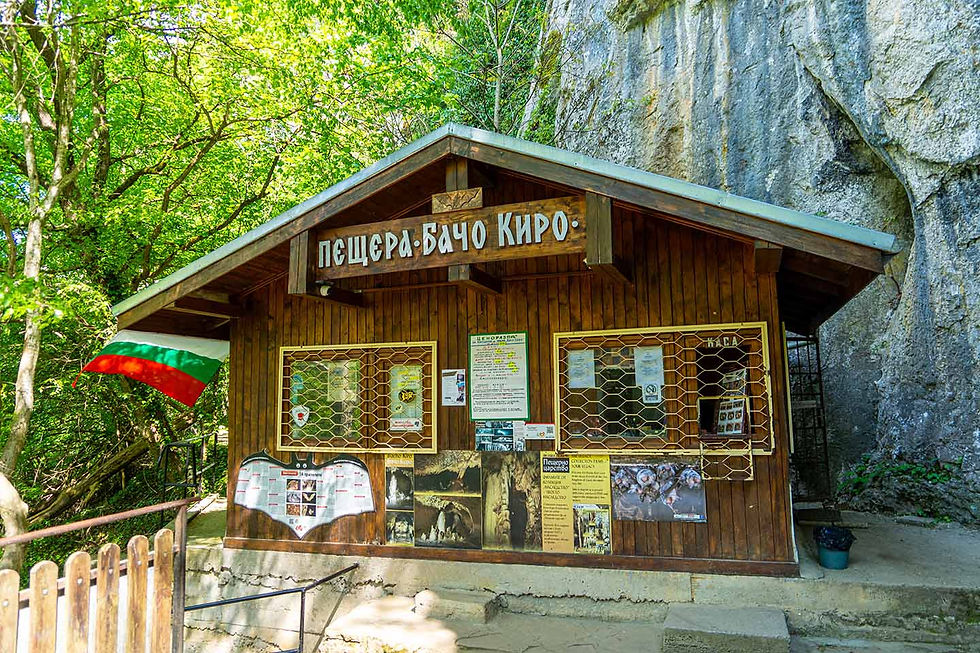
The Dryanovo Historical Museum further emphasizes this layering of history.

The monastery houses the "Archaeology and Revival" exhibition, which logically unites the monastery as a place of the most ancient culture (the cave), a spiritual center (the founding) and a revolutionary memorial (the battle).
Dryanovo Memorial Park
Dryanovo Memorial Park is closely connected with the events of the Russo-Turkish War of Liberation. It is located in the northern part of the city, on a hill that provides a panoramic view.

The park was built on the site where Russian soldiers who died between 1877 and 1878 during the Russo-Turkish War of Liberation were buried. The cemetery and memorial park were created in memory of the victims of the 35th Bryansk Infantry Regiment and other Russian units that participated in the liberation battles in the Dryanovo region and the surrounding area.

Then a hospital was built in Dryanovo, where many of the wounded on Mount Shipka (St. Nicholas - at that time) were treated. Those who died from their wounds were buried in Dryanovo and were honored in 1930 with a monument. It has a classical shape, and behind it there are stone rectangles symbolizing the nameless graves of the dead. A little to the side is also written the year of the battle - 1878. This is the place where the people of Dryanovo celebrate March 3 every year.

The central element of the memorial park is the monument dedicated to the fallen Russian soldiers. Such monuments were often erected in the period after the Liberation or at the beginning of the 20th century to immortalize the feat of the Russian troops.

The Dryanovo region, especially in the vicinity of Veliko Tarnovo and the Shipka Pass, was an important logistical and military center during the war. Therefore, the presence of a military cemetery near the town is a natural consequence of the fighting in the area - the military actions around the Stara Planina passes and the settlements in the Fore-Balkans.

Dryanovo also served as a rear base or a place for temporary hospitals, where wounded and sick soldiers died. The Dryanovo Memorial Park is part of the network of Russian monuments in Bulgaria, which preserve the memory of the victims given for the Liberation of the country. The park is a place of historical memory and national worship.
Mother Bulgaria Monument
This is another interesting landmark in Dryanovo. The Mother Bulgaria Monument in Dryanovo is different from the much more famous monument of the same name in Veliko Tarnovo, but it has its own important local significance.

It is located in the central part of Dryanovo, on a small square, right opposite the Courthouse building. It is known as the "Mother Bulgaria" monument.
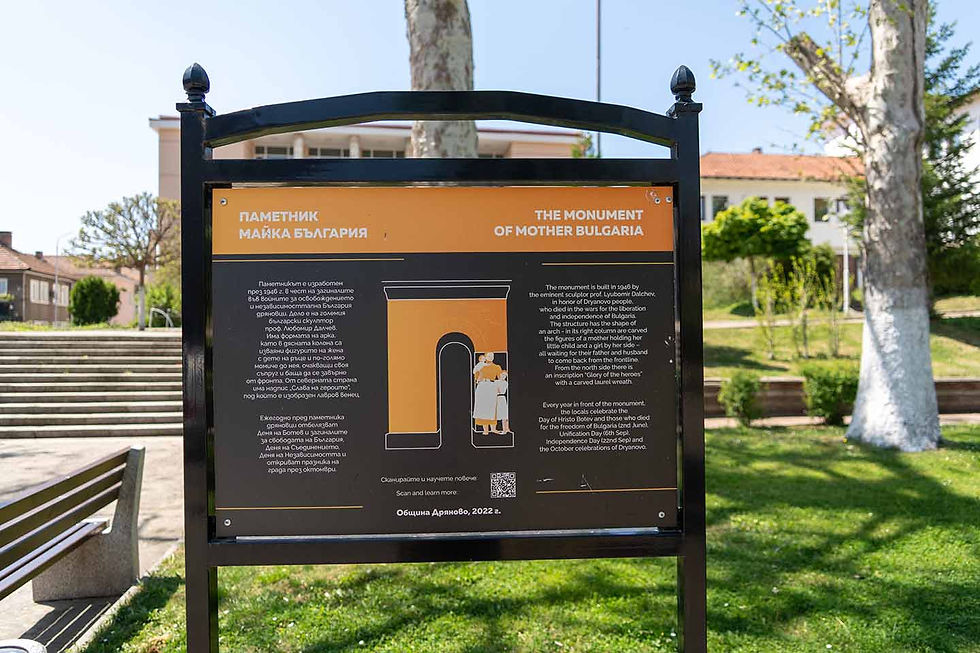
Unlike many "Mother Bulgaria" monuments, which are often dedicated to those who died in the wars for national unification, the monument in Dryanovo was erected as a symbol of Bulgarian statehood, independence and sovereignty.

Its positioning opposite the Courthouse makes it an important part of the city's central architectural ensemble, emphasizing the connection between statehood, justice, and the national spirit.
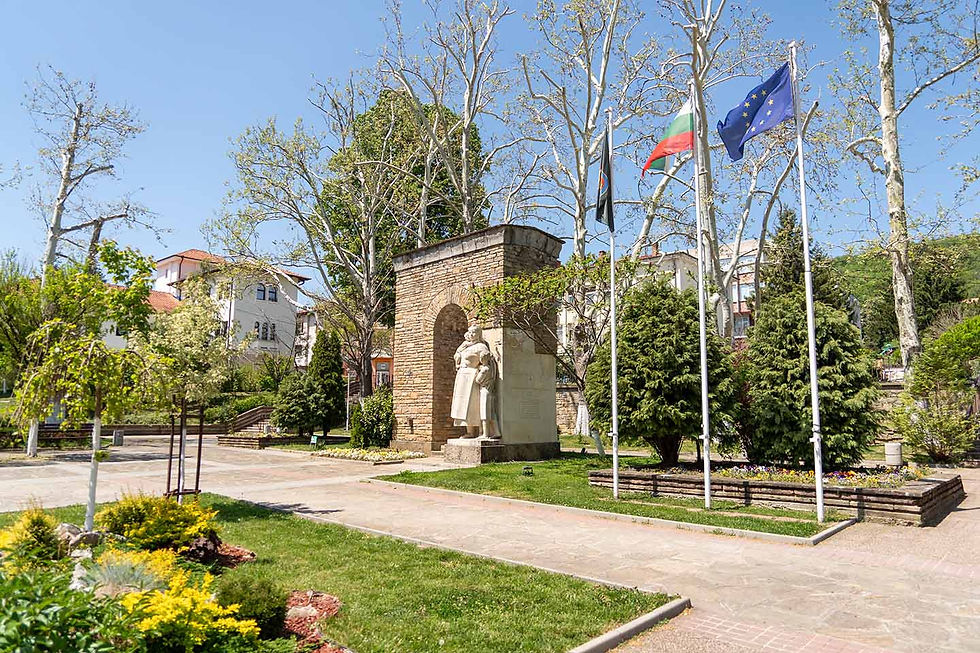
Similar monuments, erected after the Liberation, were intended to inspire national pride and remind us of the achievements of the Bulgarian people.

It is very important to make a distinction, as the most famous monument with this name is in Veliko Tarnovo. The monument in Veliko Tarnovo is dedicated to the warriors who fell for the Liberation and Unification of Bulgaria (from the Russo-Turkish War to the First World War) and was inaugurated in 1935.

Although the monument in Dryanovo is not as well known as one of the central monuments in the city, it undoubtedly represents an important symbol of local and national identity.

If you visit the place, you will see that it is a key visual dominant in this part of the city, connecting the historical significance of Dryanovo with its administrative present.
Natural and tourist attractions
The Dryanovo region is extremely rich in natural attractions, which form the basis of modern tourism. The geological features, combined with the historical sites, create a unique complex for cultural, educational and ecological routes.
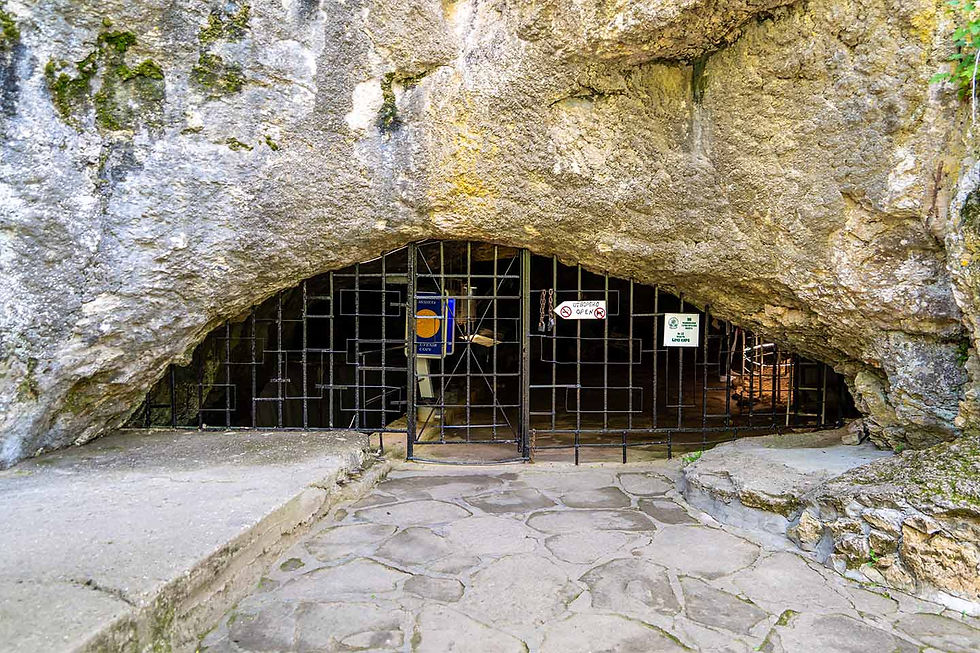
Bacho Kiro Cave is not only an archaeological site of national importance, but also an important tourist destination. It is the first developed cave in Bulgaria, the development of which began with tourists from Dryanovo back in 1937.

In the area of the Dryanovo Monastery and the town, various routes have been developed to satisfy the interests of pedestrian, cultural and cycling tourists.

The famous Dryanovska eco-trail, built in 2000, allows tourists to enjoy rare rock formations and observe rare plants from the Bulgarian flora.

Despite its rich heritage and inclusion in the 100 NTOs, the region faces significant challenges in maintaining its tourism infrastructure.
Relief Map of Bulgaria
The relief map of Bulgaria in Dryanovo is an extremely interesting and little-known fact related to the city.

It is located in the center of Dryanovo, in the park in the yard of the "Maxim Raykovich" Secondary School, right opposite the clock tower.
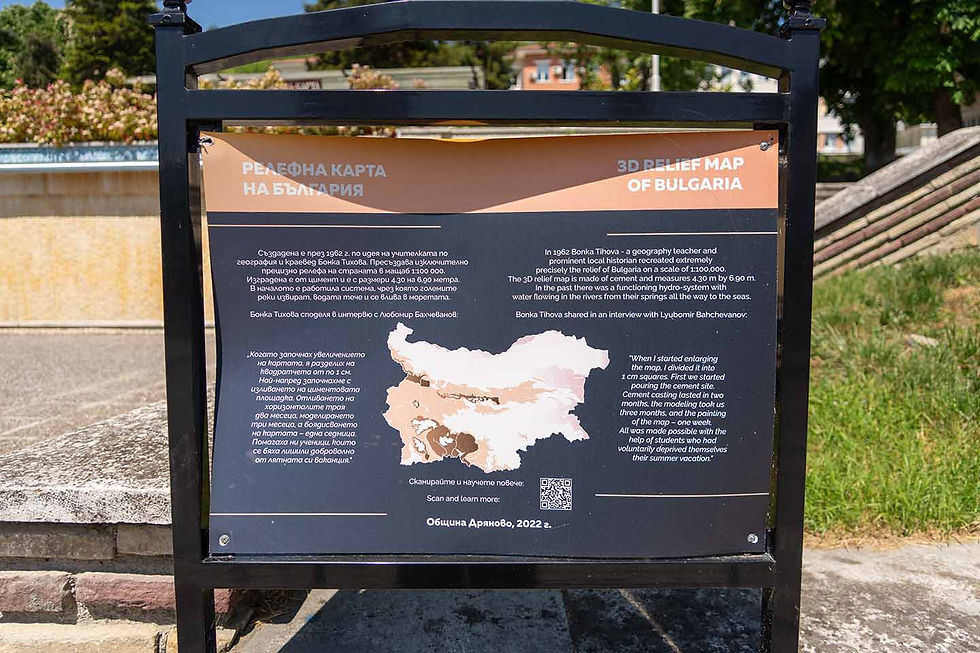
It was made back in 1962.
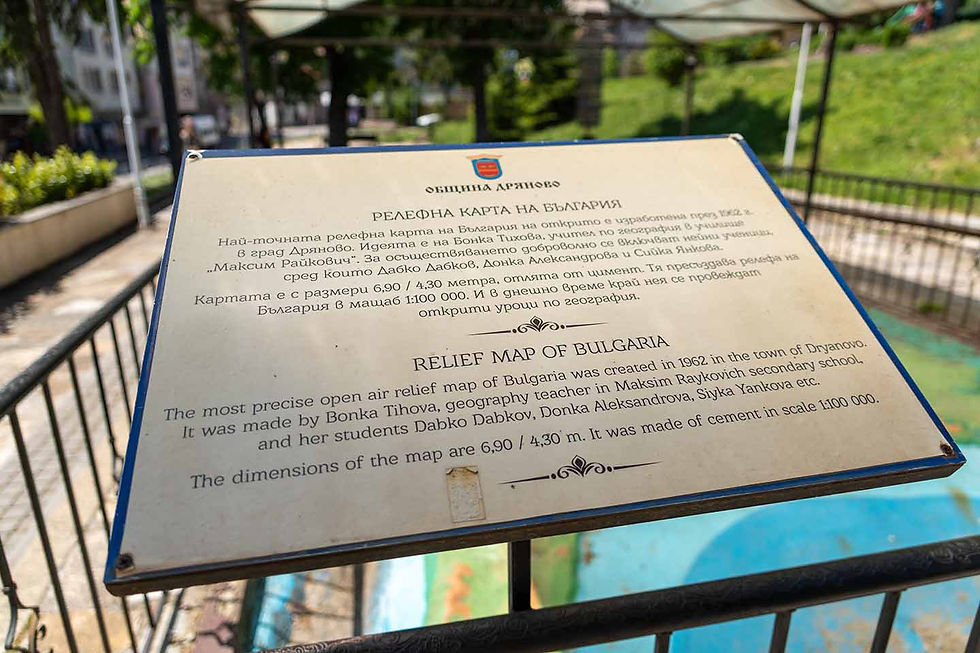
The map was created based on the idea of the geography teacher Bonka Tikhova from the high school and was made with the help of her students – Donka Alexandrova, Siika Yankova and Dabko Dabkov. The completion of the project was also assisted by specialists in geodesy and cartography from the military school in Shumen.

It is cast from cement at a scale of 1:100,000 and has impressive dimensions – approximately 6.90 by 4.30 meters.

What makes the map truly unique and impressive is that it is designed to be a working hydrological model!

In the past (and probably during its initial operation) the map was equipped with a water system.
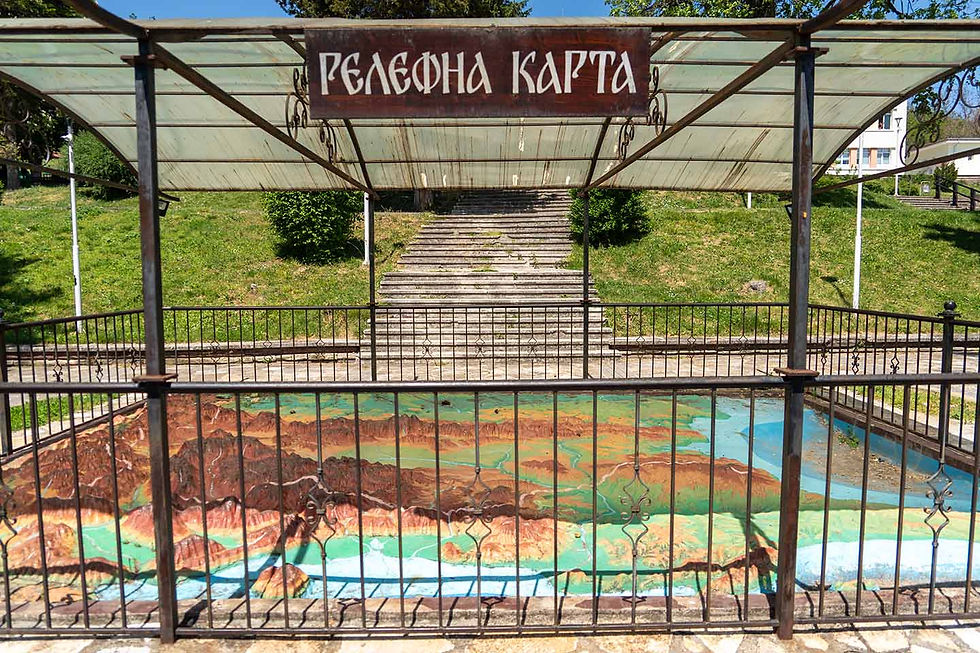
Water flowed along the beds of the main rivers, which are precisely depicted on the relief (such as Maritsa, Danube, Iskar, etc.).

The water flowed into the miniature image of the Black Sea and the basins of the other seas, thus recreating the physical geography and hydrography of Bulgaria extremely accurately and visually.

The relief map of Bulgaria in Dryanovo is the first relief physical map of Bulgaria made in this way.

It served as an extremely precise teaching aid that clearly showed the relief, mountains, plains, and drainage systems of the country.

Its creation is a remarkable example of enthusiasm and voluntary work by teachers and students, which has become a lasting landmark of the city.

Over the years, the map has suffered some damage, but in 2013 it was renovated by the youth association "MOGA-Dryanovo", which helped to preserve it.
The Dryanovo Chimney "Rings of Time" - a unique vertical encyclopedia dedicated to the millennial history of Bulgarian lands and culture
The project "The Dryanovo Chimney - Rings of Time" represents a monumental reconstruction of an old industrial infrastructure into a dynamic cultural and historical site.

Located very close to the center of the town of Dryanovo, this 45-meter industrial chimney, owned by "Platex" AD, has been transformed into a unique vertical encyclopedia dedicated to the thousand-year history of the Bulgarian lands and culture.
I show and tell in detail about the Chimney in Dryanovo "Rings of Time" HERE.
Dryanovo today
The success of the city in the future is directly related to its ability to maintain and promote its sites, especially those included in the 100 National Monuments.
Today Dryanovo is actively working to integrate and promote its rich heritage.
The city uses its architectural capital as a driver for its cultural life. Events such as the National Plein Air "Dryanovo of Master Kolyu Ficheto - Memory and Present" are organized annually, which gathers creative inspiration and tribute to the architectural heritage of the Bulgarian Renaissance. These cultural events are a direct strategy for transforming cultural capital (architecture, history, nature) into an economic resource (tourism, services).
In this way, Dryanovo becomes a unique place of memory, where geological antiquity, spiritual resilience and revolutionary heroism are intertwined in a common topographical-historical complex.
How to get to the town of Dryanovo?
Dryanovo (spelling until 1945: Drѣnovo) is a town located at the foot of the Stara Planina Mountains, in Central Northern Bulgaria.
It is located in Gabrovo Region, at the crossroads between Northern and Southern Bulgaria, near the towns of Veliko Tarnovo, Tryavna, Gabrovo and Sevlievo.
Dryanovo is located:
212 kilometers (about 2 hours and 48 minutes by car) from the capital
156 kilometers (about 2 hours and 46 minutes by car) from the city of Plovdiv
244 kilometers (about 2 hours and 57 minutes by car) from the city of Varna
227 kilometers (about 2 hours and 40 minutes by car) from the city of Burgas
The town is the administrative center of the Dryanovo municipality.
How to get to the Dryanovo Monastery "St. Archangel Michael"?
The Dryanovo Monastery "St. Archangel Michael" is located in Northern Bulgaria, about 5 kilometers southwest of the town of Dryanovo and about 15 kilometers northeast of the town of Gabrovo.

A good asphalt road leads to it.

It is served by the "Bacho Kiro" railway station, which until October 20, 1949 was named "Saint Archangel", on the "Ruse-Momchilgrad" railway line. The railway station is located about a kilometer from the monastery.
You can leave your car by the road leading to the monastery, where no parking fee is required.

Near the Dryanovo Monastery "St. Archangel Michael", as well as directly in the parking lot in front of the entrance to the monastery, parking is paid.
What can you see in the area of the Dryanovo Monastery "St. Archangel Michael"?
After visiting the Dryanovo Monastery "St. Archangel Michael" and the rich exposition of the Historical Museum - Dryanovo, pass the church "St. Archangel Michael" and head to the small and narrow door in the back of the monastery.

Coming out of it, climb onto the bridge built over the waters of the Dryanovska River.
There is a narrow path starting to the left of the bridge and winding along the river. At a normal pace, in between 5 and 10 minutes you will find yourself in front of the Sini Vir waterfall.

After enjoying the Sini Vir waterfall, you can continue towards the Andaka River canyon, the natural landmark Bacho Kiro cave and the Dryanovo eco-trail.
For this purpose, you need to return to the starting point of the trail. A few meters from this place, the waters of the Andaka River flow into the Dryanovska River, and across the way you will see a second bridge, which is called "Lovers' Bridge".

Dozens of locked padlocks hang on the railings of the bridge, inscribed with the names of the lovers who hung them here.
Walk along it, passing the restaurant. You will find yourself on the path leading towards the canyon of the Andaka River, the natural landmark Bacho Kiro Cave and the Dryanovo Eco-Trail.
The Andaka River is a small river in the Pre-Balkans, a left tributary of the Dryanovo River.
The gorge that the Andaka River forms in the area of the limestone plateau Strazhata from the Andaka Cave to the place where its waters flow into the Dryanovska River, although small in size, is fabulously beautiful. The river is dotted with numerous wonderful waterfalls, which, especially in spring, are extremely beautiful and full of water.
The path winding along the river will take you to Bacho Kiro Cave - a natural landmark and an architectural and construction monument of culture from Antiquity and the Middle Ages.
The natural landmark Bacho Kiro Cave is a complex four-story labyrinth of cave galleries and branches with a total area of about 3,600 square meters, which makes it one of the largest caves in Bulgaria.
The beautiful Dryanovo Eco-Trail starts from the entrance to the cave.

The Dryanovska eco-trail winds along the Boruna rock ridge and leads to the Bench of Love, from where a magnificent panorama of the picturesque canyon of the Dryanovska River opens.


























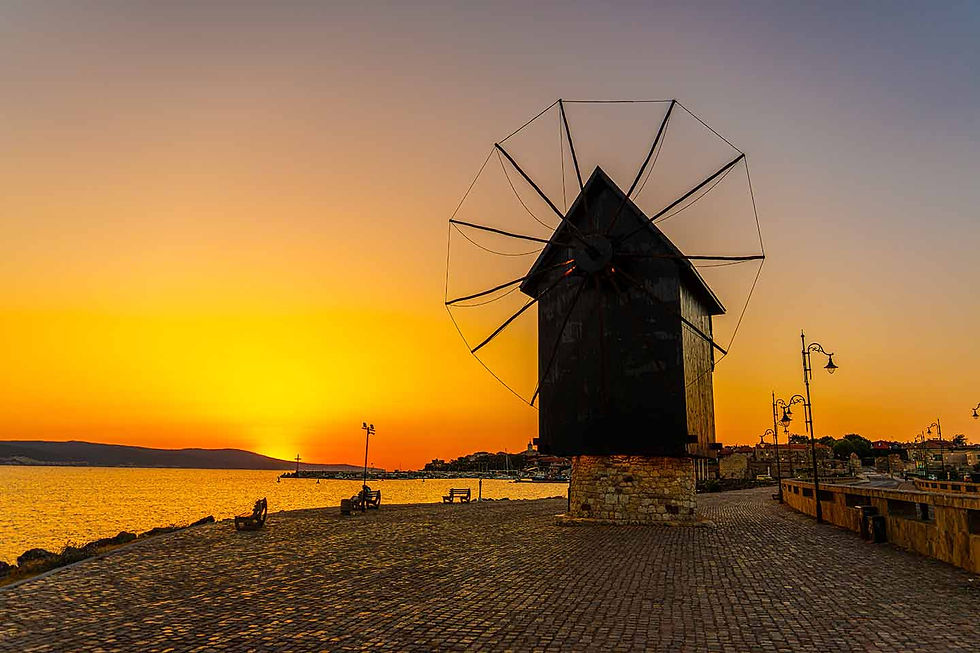


Comments